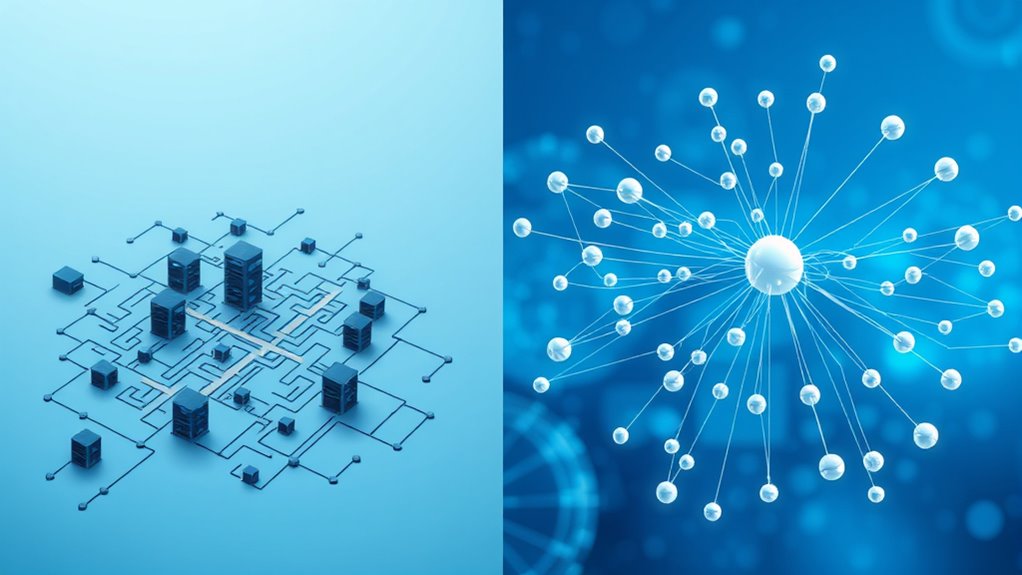Traditional B2B integration relies on point-to-point connections and batch processing, making it complex to scale and maintain. In contrast, API-first ecosystem integration leverages standardized APIs for real-time data exchange, offering greater flexibility and easier implementation. Organizations using API-first integration experience higher market capitalization (over 12%) and improved operational efficiency. While both approaches address security, API-first integration provides advanced authentication and compliance features. Understanding these key differences helps organizations make strategic integration decisions.

As organizations navigate the evolving landscape of digital transformation, the choice between traditional B2B integration and API-first ecosystem integration has become increasingly vital for business success.
Traditional B2B integration relies heavily on point-to-point connections between systems, often utilizing batch processing and scheduled data exchanges. This approach, while functional, can become increasingly complex and difficult to maintain as the number of business partners grows. The shift from batch transactions to real-time data flows has become a crucial differentiator in modern integration strategies. Organizations implementing these solutions have experienced market capitalization increases of over 12%. Modern integration solutions emphasize operational efficiency through automated data exchange processes.
API-first ecosystem integration represents a modern shift in integration architecture, prioritizing standardized APIs as the primary method for connecting systems and partners. This approach enables real-time data exchange, offering immediate access to essential information that supports faster decision-making and enhanced business agility.
Unlike traditional methods, API-first integration allows for seamless scalability without the need for creating new point-to-point connections for each partner.
The technological requirements between these approaches differ considerably. Traditional B2B integration often requires specialized knowledge of legacy systems and protocols like EDI, which can be challenging to find in today’s workforce.
In contrast, API-first integration leverages widely-taught modern protocols and standards, making it easier to implement and maintain with current IT professionals. This accessibility to skilled resources often translates to faster innovation and reduced maintenance costs.
Security considerations play a vital role in both approaches, but API-first integration offers more sophisticated options for protecting data and managing access. Modern APIs incorporate advanced authentication methods, granular access controls, and encryption protocols designed to address contemporary security threats.
Additionally, API ecosystems typically support standardized compliance frameworks and provide detailed audit trails, making it easier for organizations to maintain regulatory compliance.
The shift toward API-first ecosystem integration represents more than just a technological evolution; it’s a fundamental change in how businesses connect and share data.
While traditional B2B integration continues to serve specific use cases, the flexibility, scalability, and real-time capabilities of API-first integration make it increasingly attractive for organizations looking to future-proof their integration strategy and maintain competitive advantage in today’s digital economy.
Frequently Asked Questions
What Are the Security Risks Associated With Transitioning to Api-First Integration?
Shifting to API-first integration introduces several security vulnerabilities.
Key risks include broken object-level authorization, insufficient authentication controls, and data exposure through excessive API permissions.
Organizations face challenges with security misconfigurations, particularly in CORS settings and outdated endpoints.
Additional concerns involve inadequate monitoring, lack of rate limiting, and potential DDoS attacks.
Proper API inventory management and thorough security testing become essential to maintain protection across integrated systems.
How Long Does It Typically Take to Implement Api-First Ecosystem Integration?
API-first ecosystem integration typically takes 8-15 weeks for full implementation.
The process includes a 2-3 week research phase, 3-6 weeks for technical design and development, 2-4 weeks for testing, and 1-2 weeks for deployment.
Implementation duration varies based on factors like API complexity, team alignment, documentation quality, and legacy system compatibility.
Using established best practices like upfront contract definition and early cross-team collaboration can help optimize timelines.
Can Legacy Systems Be Integrated Into an Api-First Architecture?
Legacy systems can be successfully integrated into an API-first architecture through strategic wrapping and encapsulation methods.
Modern APIs act as facades around existing systems, translating requests and responses between contemporary and legacy formats.
Middleware solutions like Enterprise Service Buses (ESBs) help bridge architectural gaps and protocol differences.
This approach enables organizations to modernize incrementally while maintaining stable core operations and extending legacy system capabilities to new digital platforms.
What Skills Do Development Teams Need for Api-First Ecosystem Integration?
Development teams require a diverse skillset for successful API-first ecosystem integration. Core technical skills include proficiency in backend programming languages, API frameworks, and database technologies.
Teams must master RESTful principles, security practices, and documentation standards like OpenAPI. Additional competencies encompass DevOps practices, microservices architecture, and analytical capabilities.
Strong collaboration abilities and product management knowledge round out the essential requirements for effective API-first implementation.
How Does Api-First Integration Impact Existing Business Partner Relationships?
API-first integration strengthens existing business partnerships through enhanced communication and streamlined processes.
It provides clear documentation and predictable behaviors that reduce integration friction and miscommunication between partners. The approach enables faster issue resolution, improves support quality, and decreases breaking changes that could disrupt operations.
Partners benefit from increased development productivity, reliable integrations, and faster time-to-value, leading to more stable long-term relationships and reduced churn rates.









